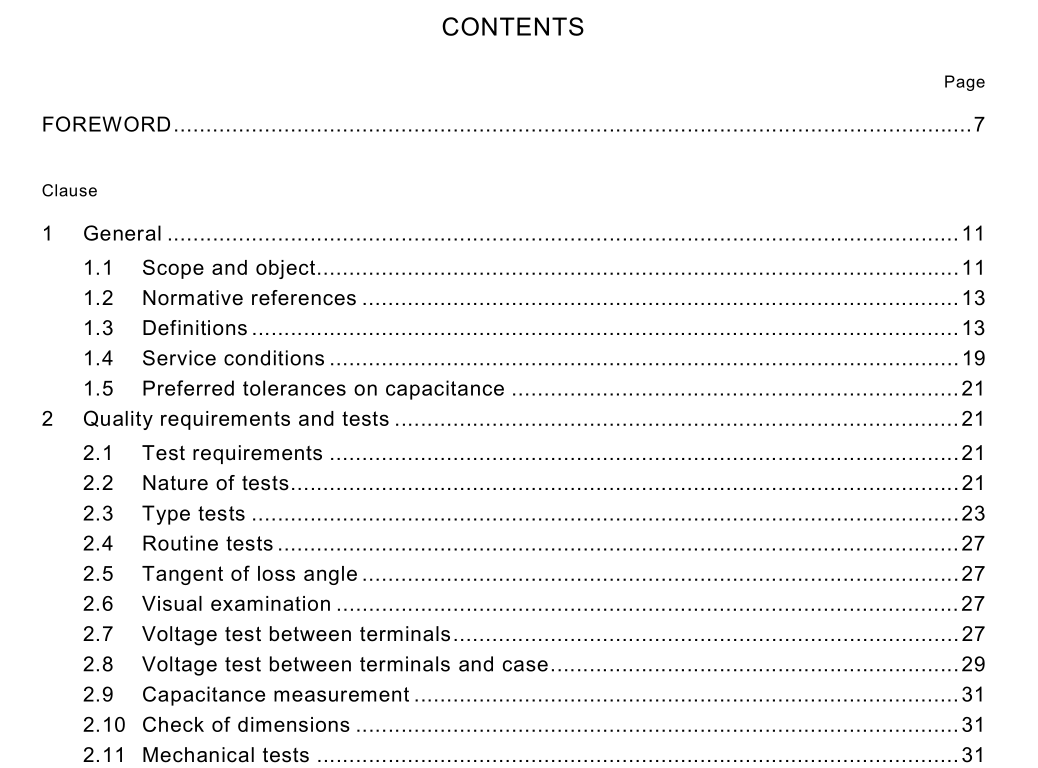IEC 60252-1 pdf download

IEC 60252-1 pdf download.General – Performance, testing and rating – Safety requirements – Guide for installation and operation
1 General
1.1 Scope and object This International Standard applies to motor capacitors intended for connection to windings of asynchronous motors supplied from a single-phase system having a frequency up to and including 1 00 Hz, and to capacitors to be connected to three-phase asynchronous motors so that these motors may be supplied from a single-phase system. This standard covers impregnated or unimpregnated capacitors having a dielectric of paper, plastic film, or a combination of both, either metallized or with metal-foil electrodes, with rated voltages up to and including 660 V. Motor start capacitors will be covered by IEC 60252-2 * . NOTE The following are excluded from this standard: – shunt capacitors of the self-healing type for a.c. power systems of up to and including 1 000 V nominal voltage (see IEC 60831 -1 ); – shunt capacitors of non-self-healing type for a.c. power systems of up to and including 1 000 V nominal voltage (see IEC 60931 -1 ); – shunt capacitors for a.c. power systems having a nominal voltage above 1 000 V (see IEC 60871 -1 ); – capacitors for induction heat-generating plants, operating at frequencies between 40 Hz and 24 000 Hz (see IEC 601 1 0-1 ); – series capacitors (see IEC 601 43); – coupling capacitors and capacitor dividers (see IEC 60358); – capacitors to be used in power electronic circuits (see IEC 61 071 -1 ); – small a.c. capacitors to be used for fluorescent and discharge lamps (see IEC 61 048); – capacitors for suppression of radio interference (IEC publication under consideration); – capacitors intended to be used in various types of electrical equipment and thus considered as components; – capacitors intended for use with d.c. voltage superimposed on a.c. voltage. The object of this standard is a) to formulate uniform rules regarding performance, testing and rating; b) to formulate specific safety rules; c) to provide a guide for installation and operation.
1.2 Normative references
The following normative documents contain provisions which, through reference in this text, constitute provisions of this part of IEC 60252. For dated references, subsequent amendments to, or revisions of, any of these publications do not apply. However, parties to agreements based on this part of IEC 60252 are encouraged to investigate the possibility of applying the most recent editions of the normative documents indicated below. For undated references, the latest edition of the normative document referred to applies. Members of IEC and ISO maintain registers of currently valid International Standards. IEC 60068-2-3:1 969, Environmental testing – Part 2: Tests – Test Ca: Damp heat, steady state IEC 60068-2-6:1 995, Environmental testing – Part 2: Tests – Test Fc: Vibration (sinusoidal) IEC 60068-2-20:1 979, Environmental testing – Part 2: Tests – Test T: Soldering IEC 60068-2-21 :1 999, Environmental testing – Part 2-21: Tests – Test U: Robustness of terminations and integral mounting devices IEC 601 1 2:1 979, Method for determining the comparative and the proof tracking indices of solid insulating materials under moist conditions IEC 60309-1 :1 999, Plugs, socket-outlets and couplers for industrial purposes – Part 1: General requirements IEC 60529:1 989, Degrees of protection provided by enclosures (IP Code) IEC 60695-2-1 /0:1 994, Fire hazard testing – Part 2: Test methods – Section 1/sheet 0: Glow- wire test methods – General IEC 60695-2-1 /1 :1 994, Fire hazard testing – Part 2: Test methods – Section 1/sheet 1: Glow- wire end-product test and guidance ISO 4046:1 978, Paper, board, pulp and related terms – Vocabulary
1.3 Definitions
For the purpose of this part of IEC 60252, the following definitions apply. 1.3.1 motor running capacitor a power capacitor which, when used in conjunction with an auxiliary winding of a motor, assists the motor to start and improves the torque under running conditions NOTE The running capacitor is usually connected permanently to the motor winding and remains in circuit throughout the running period of the motor. During the starting period, if it is in parallel with the starting capacitor, it helps to start the motor. 1.3.2 motor starting capacitor a power capacitor which provides a leading current to an auxiliary winding of a motor and which is switched out of circuit once the motor is running









